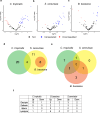Regulation of antimicrobial peptides in Hermetia illucens in response to fungal exposure
- PMID: 39609510
- PMCID: PMC11605112
- DOI: 10.1038/s41598-024-80133-7
Regulation of antimicrobial peptides in Hermetia illucens in response to fungal exposure
Abstract
The black soldier fly (Hermetia illucens) is important for antimicrobial peptide (AMP) research due to its exposure to diverse microorganisms. However, the impact of different fungi on AMP abundance in H. illucens remains unexplored. We studied the induction of AMP expression under basal conditions and with three fungi: non-pathogenic Candida tropicalis, Saccharomyces cerevisiae, and pathogenic Beauveria bassiana, using RNA-sequencing and liquid chromatography with tandem mass spectrometry. Under naive conditions, most AMPs belonged to the lysozyme, cecropin, and defensin classes, with defensins most abundant. We demonstrate that dietary supplementation with fungi is sufficient to induce AMP expression in H. illucens. However, exposure to C. tropicalis and B. bassiana also caused downregulation of certain AMPs, suggesting that these fungi may suppress or modulate the host immune response to aid in their survival and colonization. Evidently, S. cerevisiae and B. bassiana trigger similar AMP pathways, whereas C. tropicalis elicits a distinct reaction with upregulation of defensins and cecropins. Lysozymes were upregulated by S. cerevisiae and B. bassiana, but downregulated by C. tropicalis, potentially facilitating fungal survival in the larval gut. Understanding these mechanisms opens possibilities for leveraging AMPs to combat C. tropicalis, which is implicated in human diseases.
Keywords: Beauveria bassiana; Candida tropicalis; Black soldier fly; Defensin; Lysozyme; RNA-seq.
© 2024. The Author(s).
Conflict of interest statement
Declarations. Competing interests: The authors declare no competing interests.
Figures



Similar articles
-
Hemolymph metabolism of black soldier fly (Diptera: Stratiomyidae), response to different supplemental fungi.J Insect Sci. 2024 May 1;24(3):5. doi: 10.1093/jisesa/ieae050. J Insect Sci. 2024. PMID: 38713543 Free PMC article.
-
A novel family of defensin-like peptides from Hermetia illucens with antibacterial properties.BMC Microbiol. 2024 May 16;24(1):167. doi: 10.1186/s12866-024-03325-1. BMC Microbiol. 2024. PMID: 38755524 Free PMC article.
-
In Vitro Evaluation of Antimicrobial Peptides from the Black Soldier Fly (Hermetia Illucens) against a Selection of Human Pathogens.Microbiol Spectr. 2022 Feb 23;10(1):e0166421. doi: 10.1128/spectrum.01664-21. Epub 2022 Jan 5. Microbiol Spectr. 2022. PMID: 34985302 Free PMC article.
-
Antimicrobial Peptides from Black Soldier Fly (Hermetia illucens) as Potential Antimicrobial Factors Representing an Alternative to Antibiotics in Livestock Farming.Animals (Basel). 2021 Jun 29;11(7):1937. doi: 10.3390/ani11071937. Animals (Basel). 2021. PMID: 34209689 Free PMC article. Review.
-
Antimicrobial peptides in Drosophila: structures, activities and gene regulation.Chem Immunol Allergy. 2005;86:1-21. doi: 10.1159/000086648. Chem Immunol Allergy. 2005. PMID: 15976485 Review.
Cited by
-
Impact of Salmonella enteritidis Infection and Mechanical Stress on Antimicrobial Peptide Expression in Hermetia illucens.Insects. 2025 Jul 4;16(7):692. doi: 10.3390/insects16070692. Insects. 2025. PMID: 40725322 Free PMC article.
-
The fate of Candida tropicalis in the black soldier fly larvae and its nutritional effect suggest indirect interactions.PLoS One. 2025 Jul 3;20(7):e0325056. doi: 10.1371/journal.pone.0325056. eCollection 2025. PLoS One. 2025. PMID: 40608704 Free PMC article.
References
-
- Hancock, R. E. W. & Sahl, H. G. Antimicrobial and host-defense peptides as new anti-infective therapeutic strategies. Nat. Biotechnol.21, 1551–1557. 10.1038/nbt1267 (2006). - PubMed
-
- Zasloff, M. Antimicrobial peptides of multicellular organisms. Nature415, 389–395. 10.1038/415389a (2002). - PubMed
-
- Hancock, R. E. W. & Lehrer, R. Cationic peptides: A new source of antibiotics. Trends in Biotechnol.16, 82–88. 10.1016/S0167-7799(97)01156-6 (1998). - PubMed
MeSH terms
Substances
Grants and funding
LinkOut - more resources
Full Text Sources
Molecular Biology Databases

